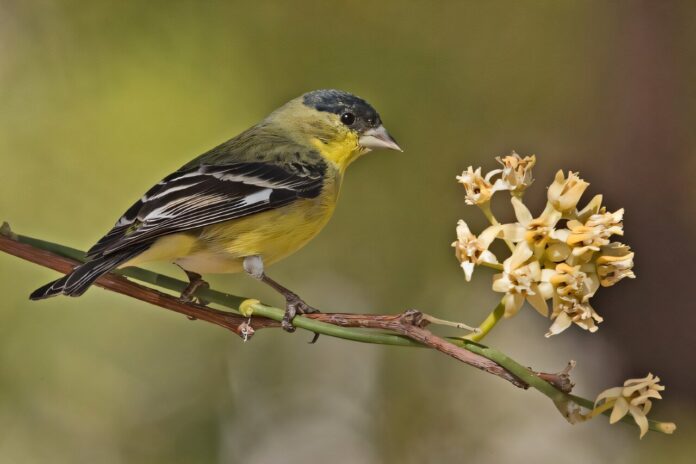New research published in the journal Ornithology shows that Lesser Goldfinches, a small songbird traditionally found in the Southwest, are expanding their range northward through the Pacific Northwest at an unprecedented rate, providing insights into how species adapt to environmental change.
Researchers from Washington State University and the Cornell Lab of Ornithology analyzed data from birdwatchers participating in two initiatives from the Cornell Lab—Project FeederWatch and eBird—to track the species’ movement. The study found that Lesser Goldfinch populations increased dramatically in Washington (110.5%), Idaho (66.3%), and Oregon (16.9%) between 2012 and 2022.
“When I first arrived in eastern Washington I was pretty new to birding and Lesser Goldfinches were new to me. I was seeing groups of 30 or 40 at a time and I sort of assumed that was normal, until I started meeting local birders who said, ’10 years ago we never had Lesser Goldfinches,’ so I started to investigate what was going on,” said Mason Maron, lead author and graduate of Washington State University.
“What’s fascinating is how these birds are adapting to human-modified landscapes,” said Maron. “They’re not just moving north randomly—they’re following specific corridors, particularly along rivers and through urban areas where temperatures are warmer and where both native and non-native plants provide food.”
The research identified maximum annual temperature, annual rainfall, urban development, and proximity to major rivers as key factors associated with the northward expansion. Although the authors noted Lesser Goldfinches appear at backyard bird feeders often, when they looked at how bird feeders might affect establishment, surprisingly, bird feeders played a minimal role in establishing new populations.
“There wasn’t really a significant association with bird feeders,” Maron said. The first individuals to arrive in a new area might go to feeders because they provide easy to access food, but Maron explained, “it’s not going to be enough to sustain a whole population.”
Rivers emerged as crucial corridors for expansion. “These rivers carry weedy plants and seeds really well,” said Maron. “We, as people, like to live along the river, so we disturb the soil and that really creates this sort of chain of the perfect conditions for them.”
Once established in new areas, the goldfinch populations remain stable. “Our results are suggestive of this species being able to pretty rapidly colonize new environments,” said Jordan Boersma, co-author and research associate at the Cornell Lab of Ornithology. “It’s not just that Lesser Goldfinches are exploring these new areas…they are moving in and typically turning into stable populations or even increasing populations.”
The Lesser Goldfinches might be shifting north in response to climate and habitat changes reported by this study, and indeed, the Cornell Lab of Ornithology’s eBird Status and Trends project indicates that Lesser Goldfinches are declining in the southern parts of their range.
While this expansion shows some species can adapt to environmental change, Maron cautions against broad generalizations: “What it really shows is that we know a lot of species are declining and struggling because of these changes. Some species can survive and adapt and do better, but it’s not necessarily a trade-off.”
“This species has proven remarkably adaptable to environmental change,” said Boersma. “Understanding how birds like the Lesser Goldfinch respond to climate change and urbanization helps us predict how other species might also be impacted.”
“When we understand how wildlife responds to environmental change, we’re better equipped to make informed decisions about urban planning, conservation, and climate adaptation,” said Maron.
The research was made possible by thousands of participants who contributed observations through Project FeederWatch and eBird. These participatory science programs provide researchers with valuable long-term data about bird populations across North America.
More information:
Mason W Maron et al, Climate and landscape modification facilitate range expansion in Spinus psaltria (Lesser Goldfinch) across the Pacific Northwest, Ornithology (2025). DOI: 10.1093/ornithology/ukaf013
Provided by
Cornell University
Citation:
Lesser Goldfinches expand north as climate and landscape modification shape new habitats (2025, April 22)
retrieved 23 April 2025
from https://phys.org/news/2025-04-lesser-goldfinches-north-climate-landscape.html
This document is subject to copyright. Apart from any fair dealing for the purpose of private study or research, no
part may be reproduced without the written permission. The content is provided for information purposes only.



